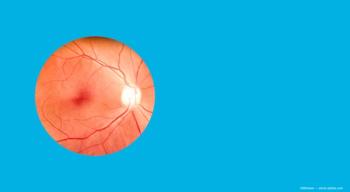
Investigators study impact of anti-VEGF treatment lapses in retinal vein occlusion
According to Jessica Liu, patients with BRVO or CRVO with any lapse in treatment of 3 months or longer are at risk for poorer outcomes.
Reviewed by Jessica Liu, and Rishi Singh, MD
Unintentional lapses in anti-vascular endothelial growth factor (VEGF) treatment of patients with retinal vein occlusion (RVO) are detrimental and can result in increased retinal thickness and lost lines of vision, reported Jessica Liu, and Rishi Singh, MD, from the Case Western Reserve University School of Medicine, Cleveland, and the Cole Eye Institute.
Anti-VEGF therapy is the first-line treatment for central and branch retinal vein occlusion (CRVO and BRVO).
“The high frequency of intravitreal injections required for anti-VEGF therapy is a potential challenge for these patients to maintain appropriate care,” Liu said.
Liu and colleagues conducted a retrospective chart review study to investigate the outcomes when the frequency of injections to treat macular edema secondary to CRVO and BRVO was interrupted for 3 months or longer between January 2012 and June 2020.
The patients were divided into 2 groups based on whether or not they had experienced a lapse in treatment (lapse vs. control groups). Patients treated based on treat-and-extend or pro re nata protocols were excluded.
The central subfield thickness (CST) and visual acuity (VA) were collected at baseline, the first appointment after lapse, and at the 3-, 6-, and 12-month follow-up evaluations.
Findings
The lapse and control groups included 69 patients each. The respective baseline CST and the best-corrected VA levels were similar in both groups (347.7 ± 127.8 µ and 365.6 ± 139.4 µ and 64.1 ± 20.6 Early Treatment Diabetic Retinopathy Study [ETDRS] and 58.9 ± 20.2 ETDRS).
Liu reported that the patients in the lapse group “experienced a significant increase in CST after discontinuing anti-VEGF therapy (lapse group, 398.7 ± 191.3 µ vs control group, 338.9 ± 119.9 µ, p = 0.034).” The lapses in treatment ranged from 3 to 62 weeks (mean, 8.6 weeks).
Importantly, resumption of treatment did not result in immediate beneficial changes. In this study, the mean increase in the CST did not begin to recover until 6 months after anti-VEGF therapy was restarted and persisted out to 1 year.
The BCVA also decreased significantly by almost 2 lines with the lapse of anti-VEGF treatment (lapse group, 54.5±25.0 ETDRS vs control group, 64.7±17.5 ETDRS, p<0.001) and persisted for 6 months after treatment was resumed.
“Patients with BRVO or CRVO with any lapse in treatment of 3 months or longer are at risk for poorer outcomes,” the investigators concluded. “Although the VA normalizes upon treatment resumption, patients experience a statistically and clinically significant increase in CST that does not recover. Further analysis may focus on the impact of persistent anatomic change present 1 year after anti-VEGF resumption.”
--
Jessica Liu
E:
This article is adapted from Liu’s presentation at the Association for Research in Vision and Ophthalmology 2021 virtual annual meeting. She has no financial interest in this subject matter.
Newsletter
Don’t miss out—get Ophthalmology Times updates on the latest clinical advancements and expert interviews, straight to your inbox.














































.png)


